Daylily is an ideal option for landscaping a summer cottage or a personal plot. Its decorativeness and attractiveness are successfully combined with unpretentious care. Despite the fact that the plant is perennial, it has a long flowering period with a wide palette of colors. And its ability to grow in a shaded area with ease of cultivation has made the daylily one of the most popular garden flowers.
Content
Use of daylilies
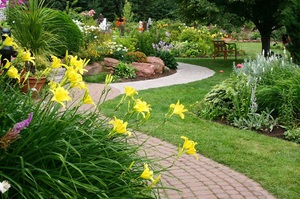 Daylilies are used in landscape design. These plants fit harmoniously into gardens of any style: oriental, country, modern, landscape, nostalgic and others.
Daylilies are used in landscape design. These plants fit harmoniously into gardens of any style: oriental, country, modern, landscape, nostalgic and others.
Plants are versatile because they can be assigned any role. So, they are used as single cultures (tapeworms) and used in mixed flower beds (mixborders). Different varieties are applied in their own way:
- In landscape design, for decorating rockeries and alpine slides, they turn to undersized varieties.
- With their help, ribbons and borders are created, that is, hedges. They choose varieties with a dense structure that do not give root layers. Designers recommend combining varieties that bloom at different times, but they should have approximately the same height of greenery.
- The composition should consist of varieties collected for certain reasons, which would complement each other. Often dwarf varieties are planted in the foreground, medium-sized plants in the middle, and tall plants in the background.
- The color in the composition is also very important for visual perception. So, saturated and dark in color varieties are defined in the middle of the flower garden, since in the background they will reduce the space of the territory, the composition will have a flat appearance.
- Daylilies that do not grow tall are used to decorate alpine hills and rockeries.
- Siloam Double Classic is an incredibly fragrant daylily with delicate pink flowers. He is seated near a gazebo or bench to enjoy its aroma. This extraordinary flower will not leave anyone indifferent. A photo of this flower can be seen in the catalog.
Combinations of daylily varieties with other plants
What colors do they form a single composition with?
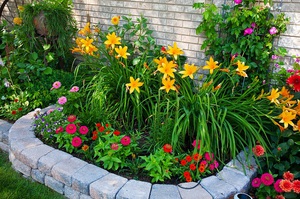 Daylilies go well in flower beds and compositions with dahlias, loosestrife, reed grass, twig millet, knifofia, catnip, long-leaved veronica, crocosmia.
Daylilies go well in flower beds and compositions with dahlias, loosestrife, reed grass, twig millet, knifofia, catnip, long-leaved veronica, crocosmia.- Varieties blooming with yellow, brown-bronze, orange shades are harmoniously combined with agapanthus. Such a composition will be distinguished by brightness, contrast and beauty.
- Against the background of crocosmia, red flowers with a yellow center of the Matador and Grand Opera varieties look great. They are the accent of the composition and will surely attract the eye.
- Daylilies of purple color go well with phlox Amethyst.
Daylilies give an excellent combination with bulbous crops... They are planted next to tulips, hosts, irises, astilbe, crocuses, hyacinths, delphiniums.
Bulbous plants should preferably be planted in the foreground to help protect them from overheating. The flowerbeds will gain brightness from this, however, they will not be intrusive.
All varieties of daylilies, both tall and dwarf, can develop well in various containers, tubs, pots. For this you just need choose the right container... The plant has a powerful root system, so a voluminous flowerpot is needed.
They are used to decorate balconies, terraces, front gardens, garden areas and recreation areas. They feel good in winter gardens. Daylilies can also exist in urban environments. It is being actively implemented in the landscape for landscaping streets, territories near parking lots and shops.
Choosing a variety for growing
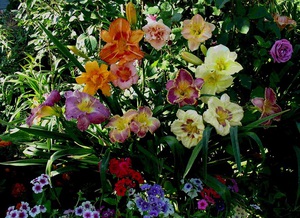 For flowers to appear in all their splendor, they need a suitable background. To do this, you can adapt a flat lawn, a hedge or a group of trees, shrubs that cover the horizon line.
For flowers to appear in all their splendor, they need a suitable background. To do this, you can adapt a flat lawn, a hedge or a group of trees, shrubs that cover the horizon line.
In the background, coniferous and deciduous crops can be located. The daylily variety should be chosen from a ready-made living area for growing. So, if there are dark green plants in the background, then bright ones will look advantageous, for example, yellow and variegated varieties daylily, if the background is variegated - solid or saturated.
Tall daylilies, which develop dark flowers, look great against the background of light leaves of shrubs.
Unfortunately, at the end of summer, many varieties lose their beauty, their foliage turns yellow and dies off. Therefore, before planting the daylily find them a partnerthat will cover their wilted foliage.
For these purposes, decorative cereals can be in a composition with daylilies, which differ in different shades:
- physostegia;
- lyatrice;
- loosestrife point;
- yarrow.
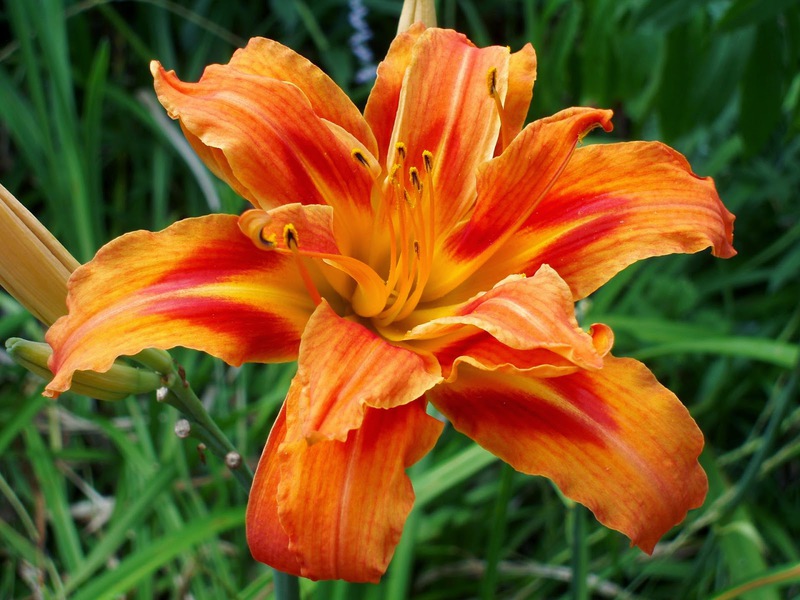
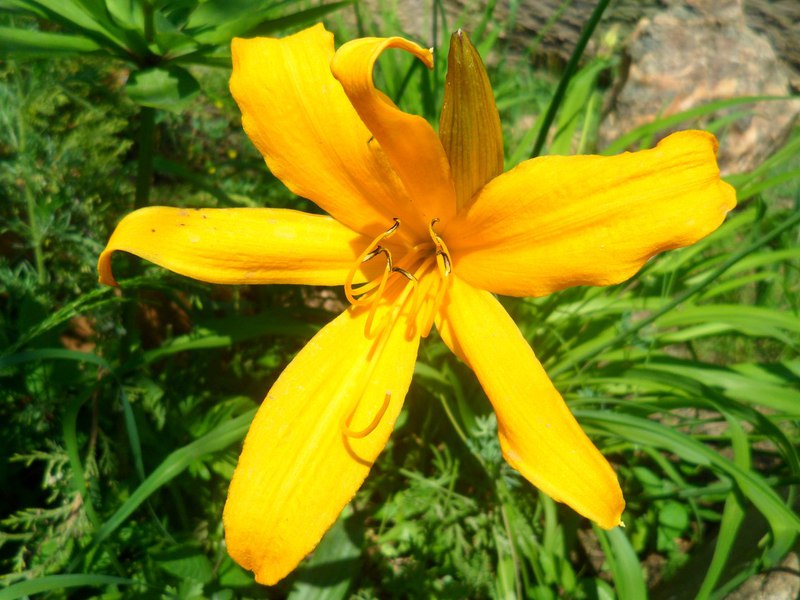


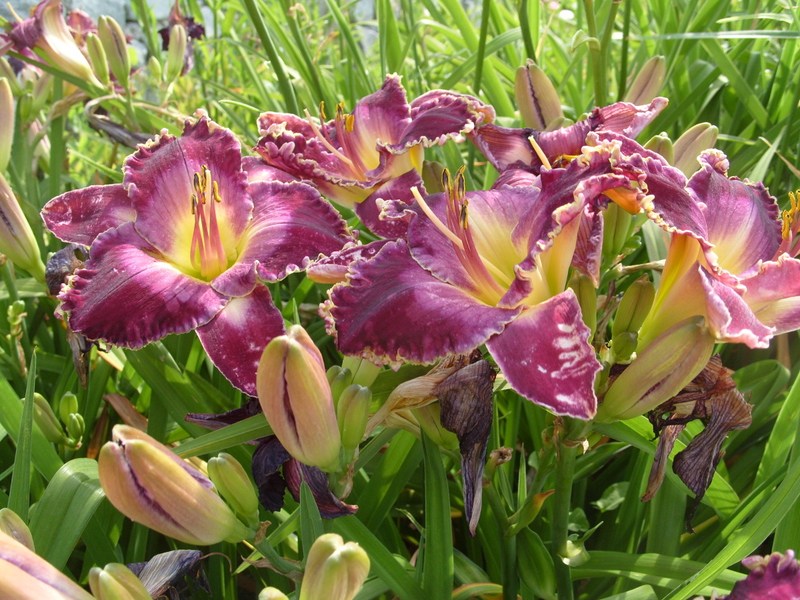
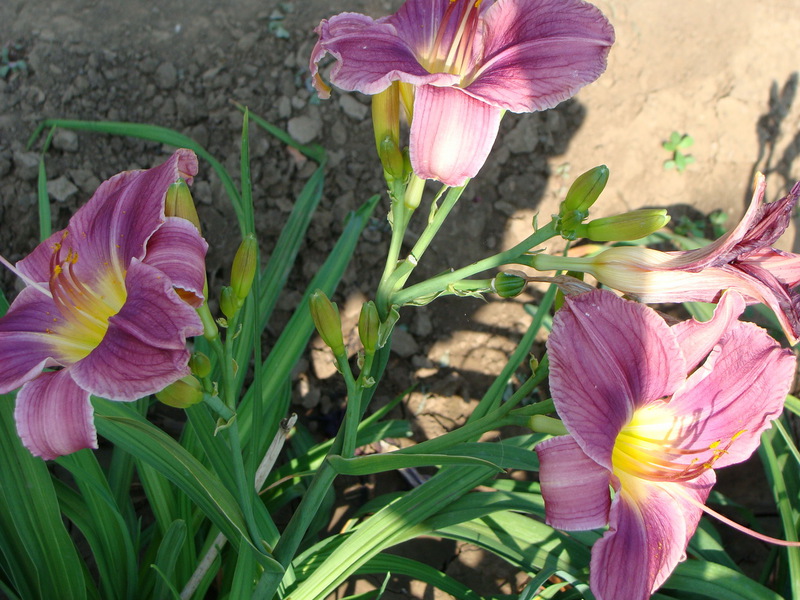
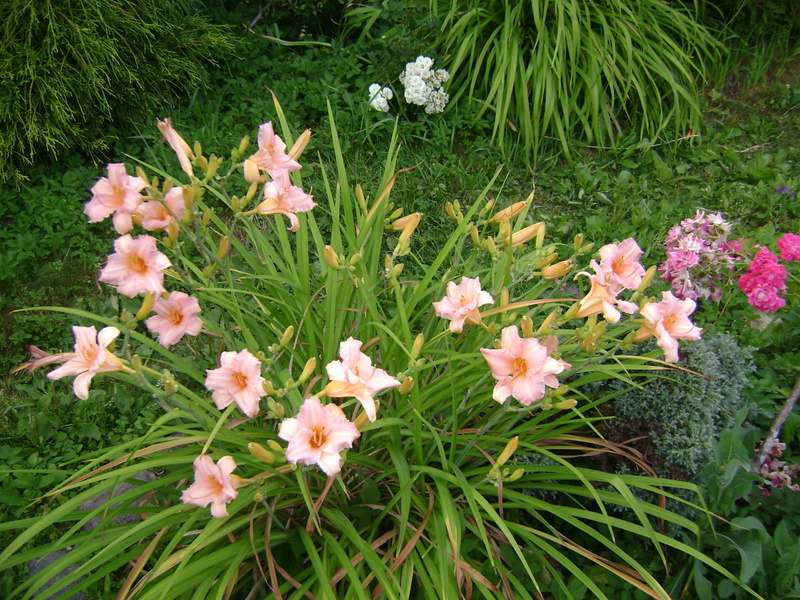
Daylilies in the catalog count about 62 thousand varieties... In our country, the following are most popular:
- In the photo, the daylily is brown-yellow. It is a powerful shrub up to 1 meter, leaves are dark green, wide 2.5 cm. It is hardy, easily adapts to a place located in the shade, and grows widely and quickly. Flowers are orange-red. There are a number of terry varieties.
- A bush grows up to 60 cm Middendorf daylily. It blooms profusely in May-June with yellow-orange flowers with a strong aroma.
- The daylily Citrine reaches 105 cm. In the first half of summer, it provides abundant flowering of lemon shades.
- Hybrid varieties are represented by Stella de Oro. It grows dwarf, has bright yellow flowers, which delight with their beauty for about 4 months.
- Midnight Magic has large flowers, reaching 14 cm, a shade of dark burgundy.
- Margaret Perry forms dark pink flowers from July to August, up to 15 cm in diameter.
- Prairie Blue Ice has a lavender color. The diameter reaches 14 cm.
Care rules
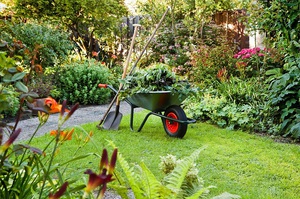 Due to their unpretentiousness, these plants are called “flowers for intelligent lazy people”. However, in order for them to look neat and well-groomed, as well as abundantly and bloom for a long time, you still need to follow them, and first create certain conditions.
Due to their unpretentiousness, these plants are called “flowers for intelligent lazy people”. However, in order for them to look neat and well-groomed, as well as abundantly and bloom for a long time, you still need to follow them, and first create certain conditions.
When choosing soil, keep in mind that it must be rich in organic matter, have good drainage, loose loam with an acidity of 6-6.5 pH. Dilute clay soil with compost and sand, lime will help lower the acidity level. Alkaline soil can be flavored with peat.
Good lighting is optional, as the daylily is quite adapt to partial shade and even shadows. However, in bright light, when daylight hours lasts about 6-7 hours, its flowering will become more abundant and massive, colors will acquire saturation. Hybrid varieties are very fond of the soft sun.
Features of watering, feeding and transplanting
 The powerful root system of daylilies is adapted to the fact that during dry periods it can get moisture from the depths. Therefore, a long drought tolerate wellhowever, the quality of the buds suffers and becomes small and rare.
The powerful root system of daylilies is adapted to the fact that during dry periods it can get moisture from the depths. Therefore, a long drought tolerate wellhowever, the quality of the buds suffers and becomes small and rare.
During the snowmelt period, in early spring, the plant should be protected from stagnant water. Although the culture copes well with temporary difficulties, it is still necessary to ensure that the root collar is above the water.
The best option is to keep the top layer of the earth dry (where the rosette of leaves develops), and the level of the suction roots, which are located at a depth of 20-30 cm from the surface of the earth, moist.
To achieve this, they resort to mulching with a tree crust or dry peat. The best thing water in the evening... The plant is moistened with a stream of water directed under the bush. From above, daylilies should not be watered in order to exclude the appearance of spots.
It is desirable to feed, because flowers are grateful for active growth and abundant flowering. Fertilizer is selected based on the characteristics of the soil. With their help, the deficiency of those elements that the soil lacks is compensated. Before fertilizing, the plant is watered with plain water so as not to burn the roots.
A daylily transplant is necessary in 5-7 years. Required pruning flower shoots after flowering. In late autumn, the ground part of the bush is completely cut off.
So, daylilies are unpretentious and, with the correct selection of varieties, are capable of to give the beauty of flowering from early spring to late autumn. And the compositions composed of these perennials, supplemented by other plants, will amaze the imagination of the most sophisticated natures.


